
Marienplatz (German title: Marienplatz) is the Central square and the heart of Munich.
This area may be known as Marienplatz, Mary's square, St. Mary square, or the square of our lady (Mary's Square / St. Mary, Our Lady's Square).
Located Marienplatz in the center of Munich's Old town, surrounded by many attractions including historic buildings and churches. Run into the square one of the Central streets of the historic center of Munich, including: Sendlinger Strasse (Sendlinger Str.), Theatinerstraße, Residenzstraße, Burgstraße underground station, Kaufingerstraße, street Tal and others.
Marienplatz is the heart of the city centre ever since, when Henry the Lion founded the city of Munich (1158).
On the area for a long time existed different markets: eggs, cereals, wine and fish. Therefore, the Marienplatz called simply as "the Bazaar" or "square".
During the history of the area was also the site of executions and was used for knightly tournaments, festivals, celebrations and rallies.
Since 1566, due to the construction of the public estates, which were based on representatives of estates, Marienplatz became a political site of activity, which has remained to the present day.
During the Second world war the buildings surrounding the Marienplatz, was badly damaged. Historic buildings on the South side of the square was lost forever, the ruins of these buildings were subsequently demolished and a new construction line was partially moved several meters back (to the South) to create more space for the square.
Today the Marienplatz is the city centre of Munich and the pedestrian zone. The dimensions of the square are: 100 meters long and 50 meters wide.
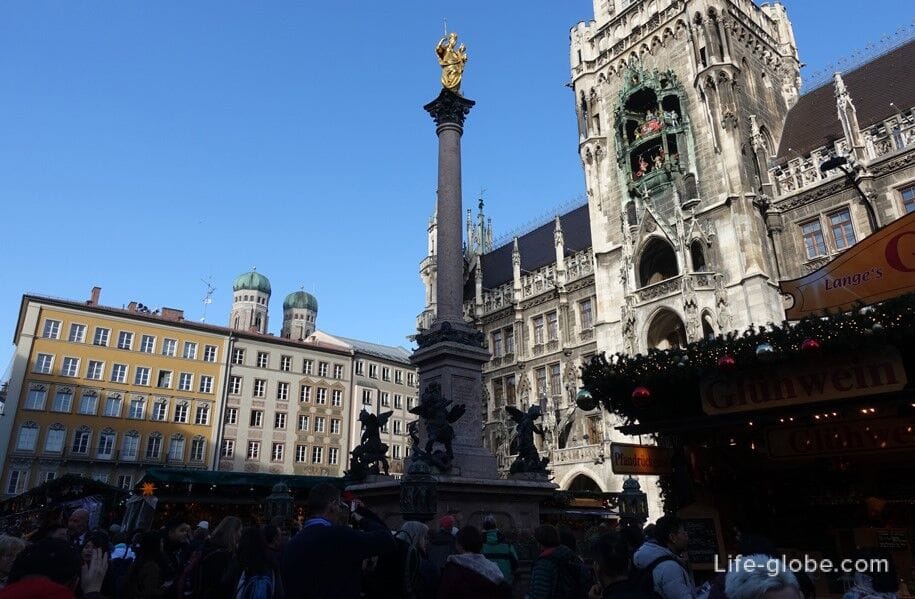
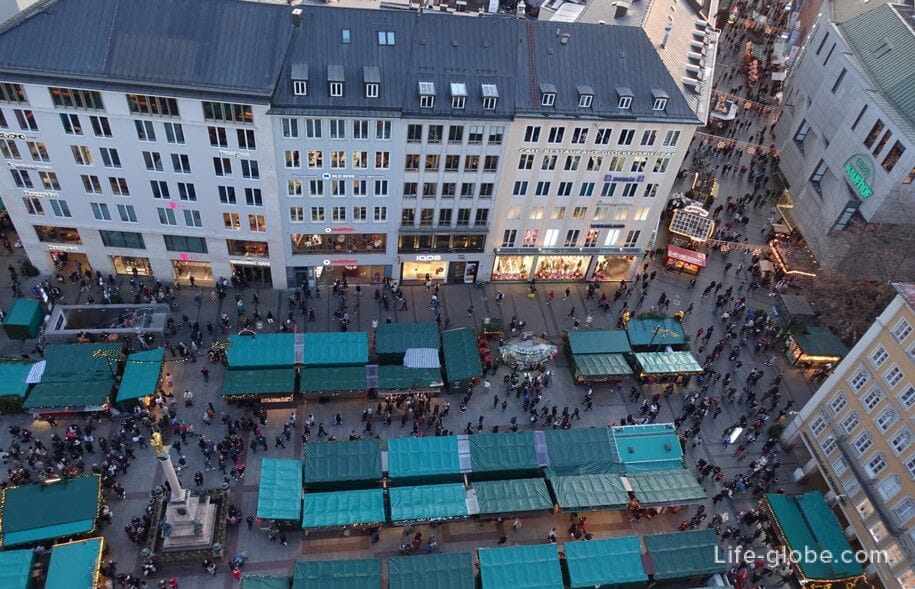
From the South and West sides of the square are more modern buildings to replace those that were lost during the war. On the first floors of these buildings are shops, there are cafes.

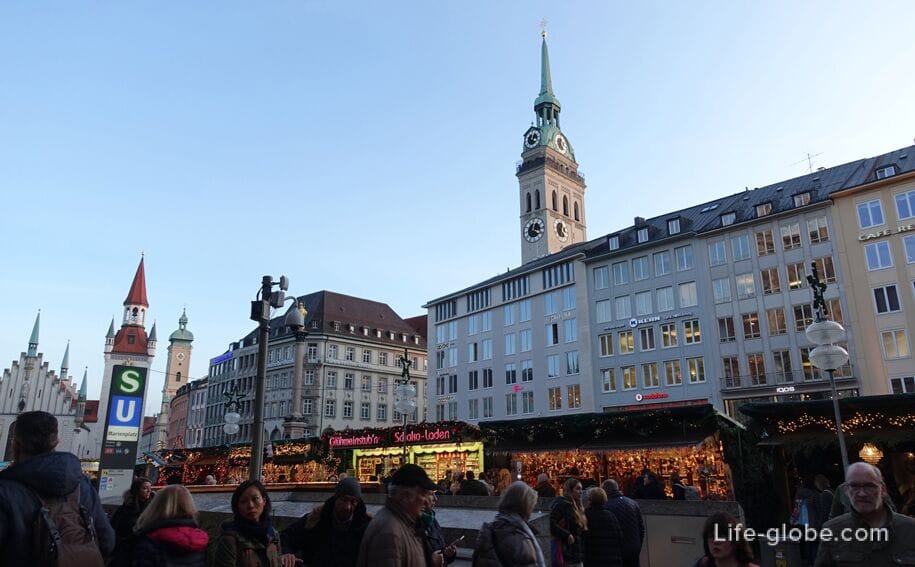

The Northern and Eastern side of Marienplatz mark two hall: New and Old.
New town hall (Neues Rathaus) is a magnificent neo-Gothic building of brick and stone that takes up almost the entire Northern part of Marienplatz and is the dominant of the square.
Conveniently located in Marienplatz, New town hall - the first thing that catches the eye and seems to stand up and be considered the facade of the New town hall can be infinitely long.
The new city hall was built between 1867 and 1909.
Currently, town hall is a complex of buildings with courtyards and is the seat of the mayor and the headquarters of the city Council of Munich.
In addition, the walls of the hall are: hall of the exhibition centre; visitor centre; café and shops located on the first floor of city hall.
On a high tower of the town hall housed the famous glockenspiel clock (Rathaus-Glockenspiel), moving figures which play daily performance: when the musical sound of 43 bells open window hours, and at two sites figures show scenes from the history of Munich.
In the upper part of the town hall tower is an observation deck, granting a 360 degree view of Munich. Read more about New town hall, including hours and the observation deck...
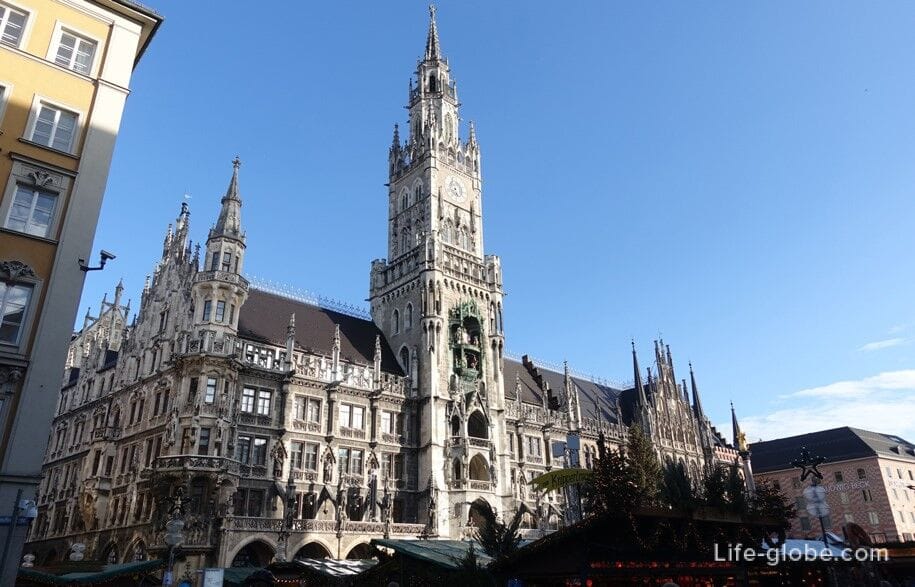
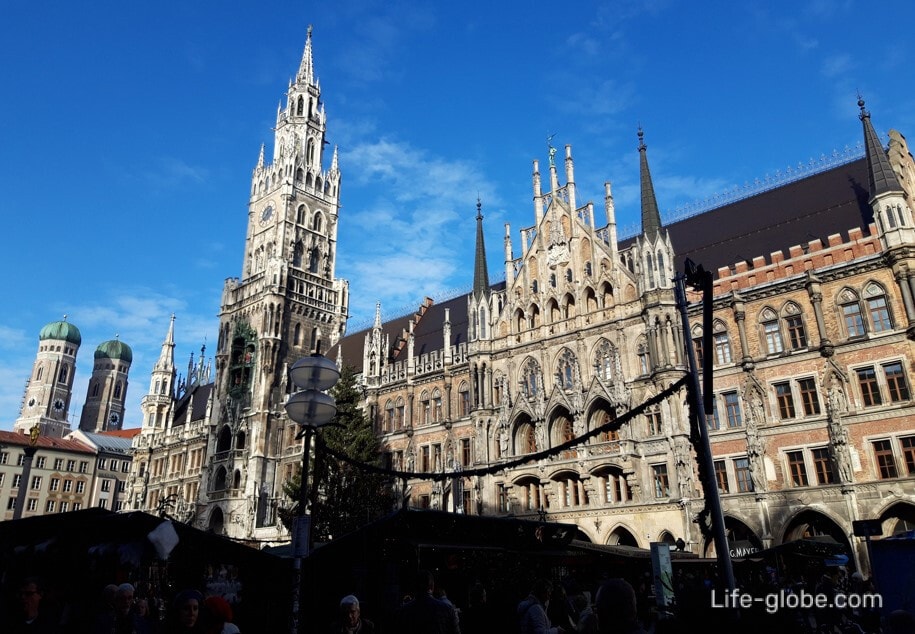
The views from the observation deck of the New town hall
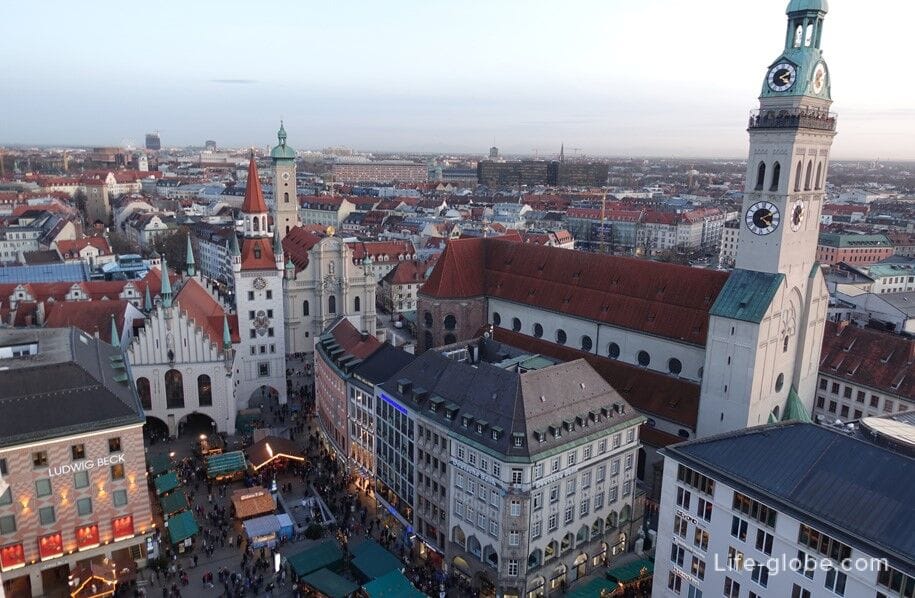
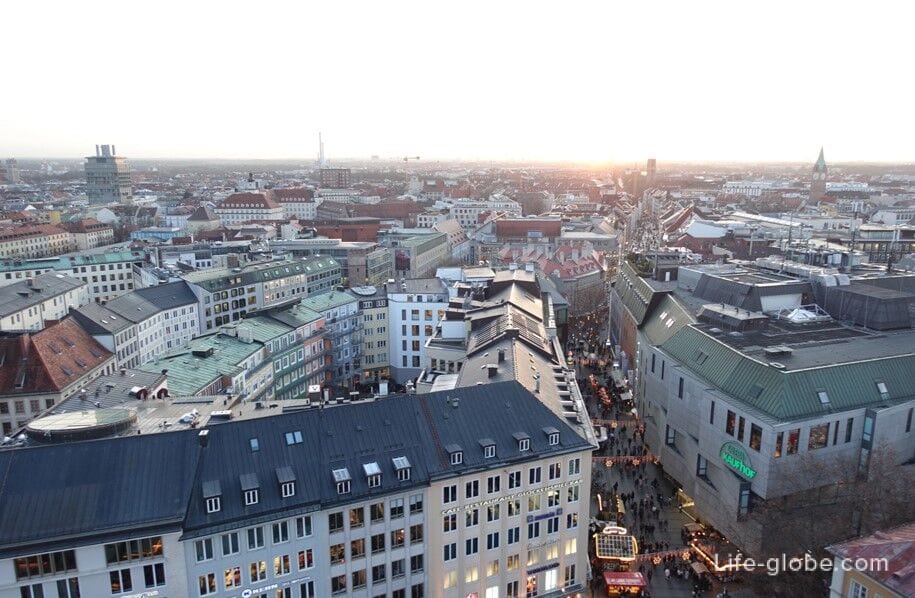
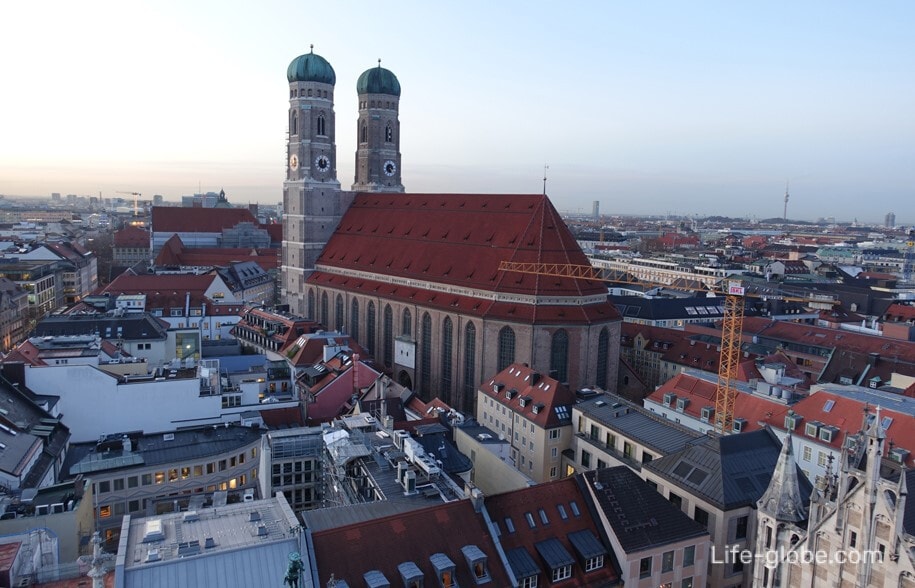
Old town hall (Altes Rathaus) dates back to the 14th century and is the forerunner of the New town hall.
The architecture of the old town hall noteworthy: a statue of Ludwig I of Bavaria, located on the Western facade of the town hall and the statue of Henry the Lion - on the East facade. Two facades of the town hall tower in Munich is decorated with coats of arms and round the clock.
Within the walls of the Old town hall is the Ballroom (Festsaal Der), which is from 1476 was one of the architectural masterpieces of the Munich Gothic style.
The four floors of the town hall tower is a Museum of toys (Spielzeugmuseum), private collection which shows the development of toys over four centuries. Read more about Old town hall...
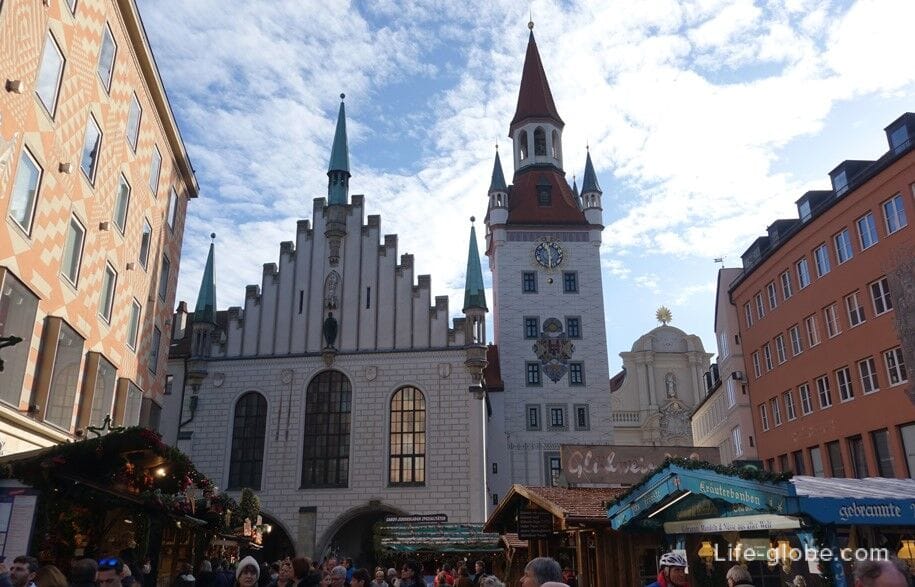
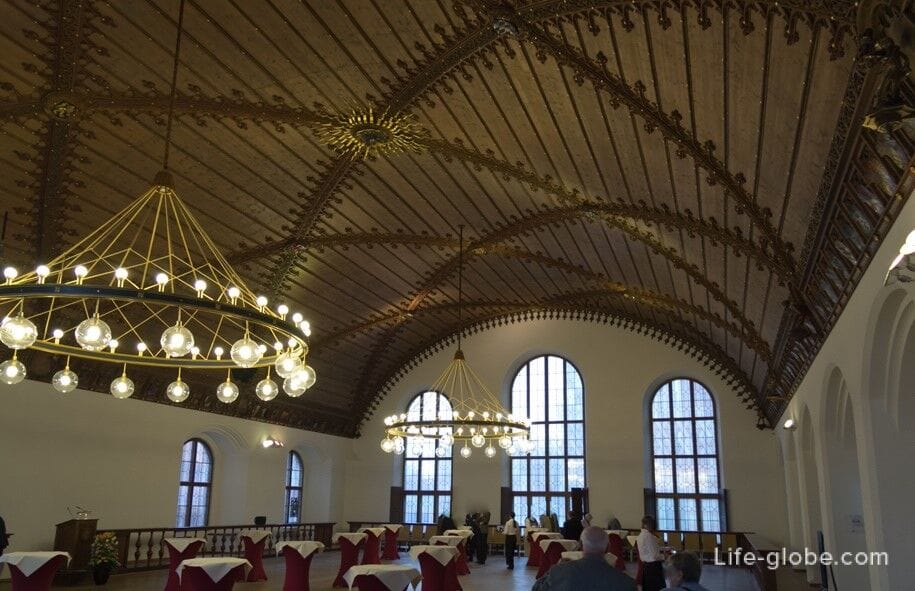
Near side (South) facade of the Old town hall is the famous sculpture is the bronze statue of Juliet (Julia-Capulet Statue).
On the left, the arm bent, Juliet often holds flowers and raises the right long dress.
There is a belief that if you RUB the right breast of Juliet, you will be happy in love.
Statue of Juliet were donated to Munich's sister city Verona.
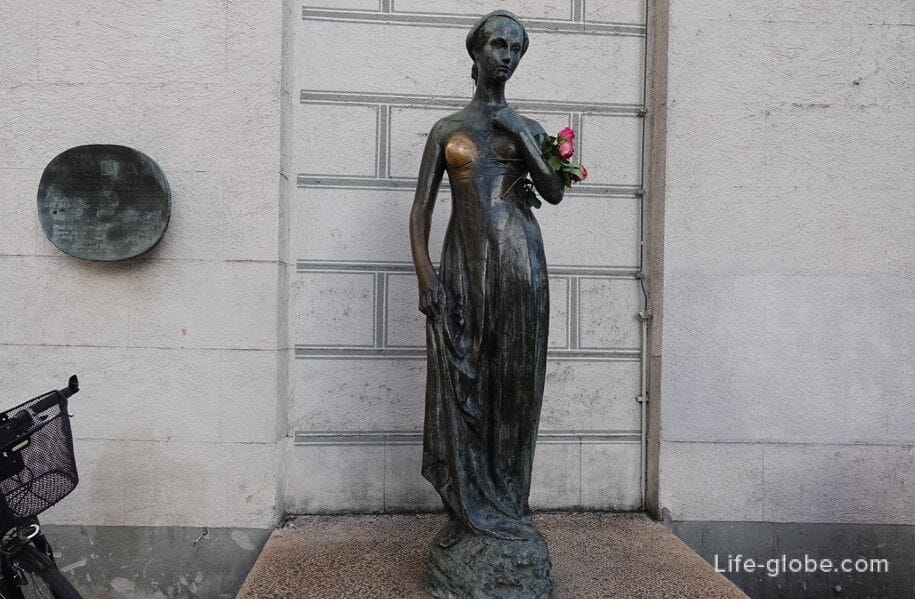
Center the Marienplatz is adorned with a high column of Mary, also known as the Marian column or Mariina column (Mariensäule) which is dedicated to St. Mary as "the patroness of Bavaria".
The column was erected in 1638 to celebrate the end of Swedish occupation during the Thirty years war.
A column with a height of more than eleven meters is crowned by a statue of Mary (Hubert Gerhart, about 1593). In her left hand Mary holds the Christ child, and in the right a sceptre. The voice of the statue adorns the crown, and placed her naked Crescent. It symbolizes faith and hope.
Black sculpture composition at the base of columns represent the four disasters of the time overcome by the city: a heresy (the serpent), war (lion), hunger (dragon) and the plague (Basilisk), which the win brave putti - the child in the guise of a warrior angel.
As a monument of thanksgiving for the salvation of the country and the princely house, Marian column is still a place of public worship and prayer.
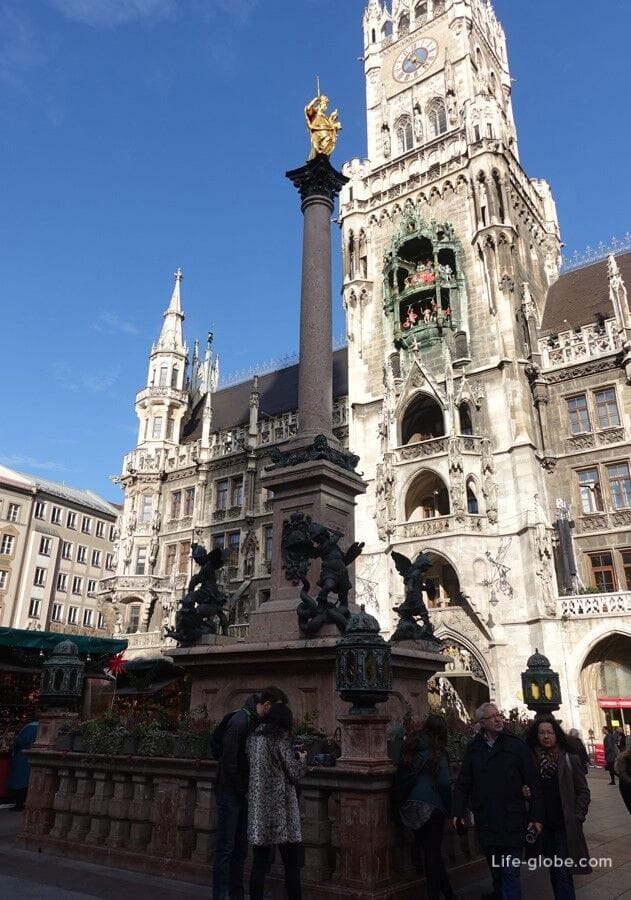
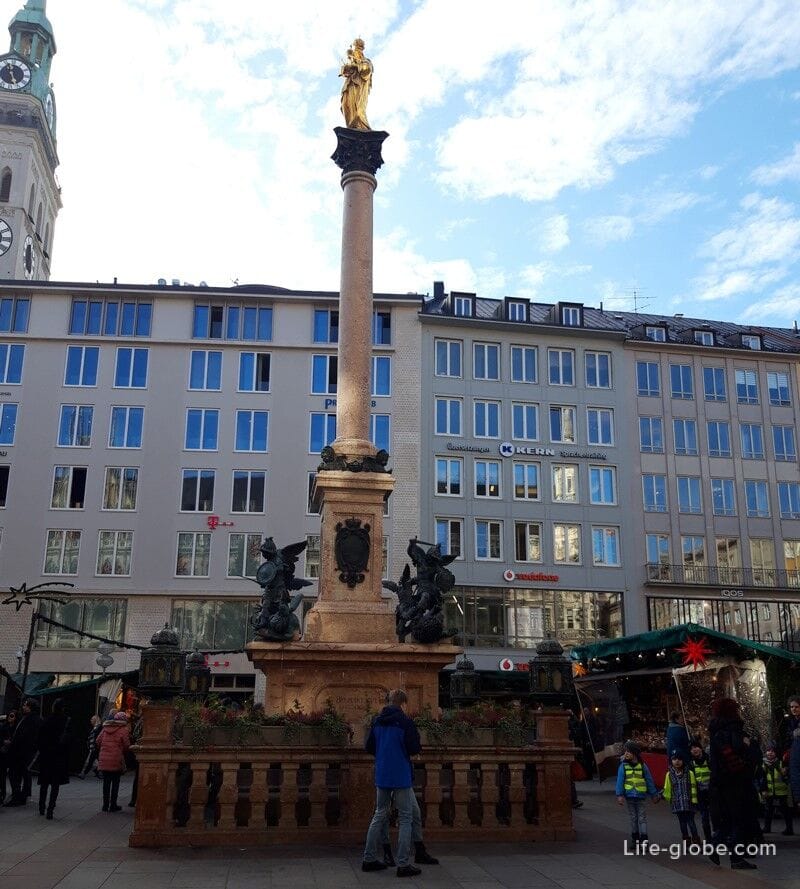
On the Marienplatz, near the South-Eastern corner of the New town hall is the "Fish"fountain (Fischbrunnen).
Fish, the fountain is named because in this place since ancient times, has traditionally been a fish market. Today the market has gone, and in the memory of the past left the fountain.
A fountain existed on the Marienplatz in ancient times, the first mention of which dates back to 1318 year. The predecessor of the fountain was a well that was fed from groundwater under the center of the city.
The fish fountain was designed by sculptor Konrad Mollom and built between 1862 and 1866 years. The fountain was destroyed during the Second world war and restored by Joseph Henselmann in 1954 with the use, including the surviving figures.
Today the water in the fountain is not intended for drinking. The fountain consists of a small octagonal pool turquoise colors, thanks to which the water in the tank burns very brightly.
In the center of the tank has a wide column, around which are placed three bronze sculptures of the boys-butcher, who poured water into the pool from buckets. The top of a column decorated with a bronze fish-ball (sculptor Otto Kallenbach).

With Fish fountain associated with interesting customs:
1. Cleaning purses. This tradition dates back to 1426; as then, so now, the cleaning of the purses takes place on ash Wednesday.
In ancient times the citizens to attract the attention of employers to the fact that after a fun and zagulnym celebrations of a carnival period, their wallets were empty and it was necessary to increase wages and bathe their empty wallets in the fountain.
The hope is that the bathing purse is not only a positive impact on the financial position of individuals, but will also benefit the municipal cash register. This is why emissaries from the city participate in this tradition since 1950-ies. In Munich spectacle every year is revived with the mayor or one of his deputies.
According to legend, such action should guarantee that you spend the rest of the year without financial worries.

2. Jump butcher: after the baptism of discipleship. Water has always been considered a cleaning tool, including for the butchers of Munich, who since 1995 to restore the old tradition of jump the butcher in the Fish fountain every three years.
This is a kind of Epiphany, which celebrates the end of the apprenticeship. In the past students, butchers dressed in sheep's clothing, hung with the tails of lamb and veal, walked through the streets to the well with the fish. There they were released from their apprenticeship and jumped into the water. They went into the water and after the water was poured from buckets.
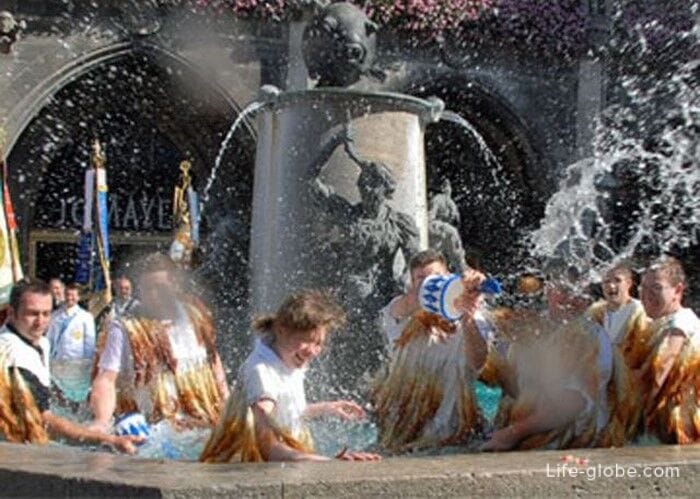
Under the Marienplatz station, where the lines U3 and U6 Munich underground with the Central line of the Munich s-Bahn.
Especially popular Marienplatz square becomes Christmas eve and New year's, when the square features a Christmas market, tree set, and the tents and stalls outside the city centre and are also available on the surrounding streets.
From the tents there is a lively trade of drink, including warming mulled wine, food (sausages, burgers, cabbage, etc), snacks, sweets, food, Souvenirs and Christmas goods.



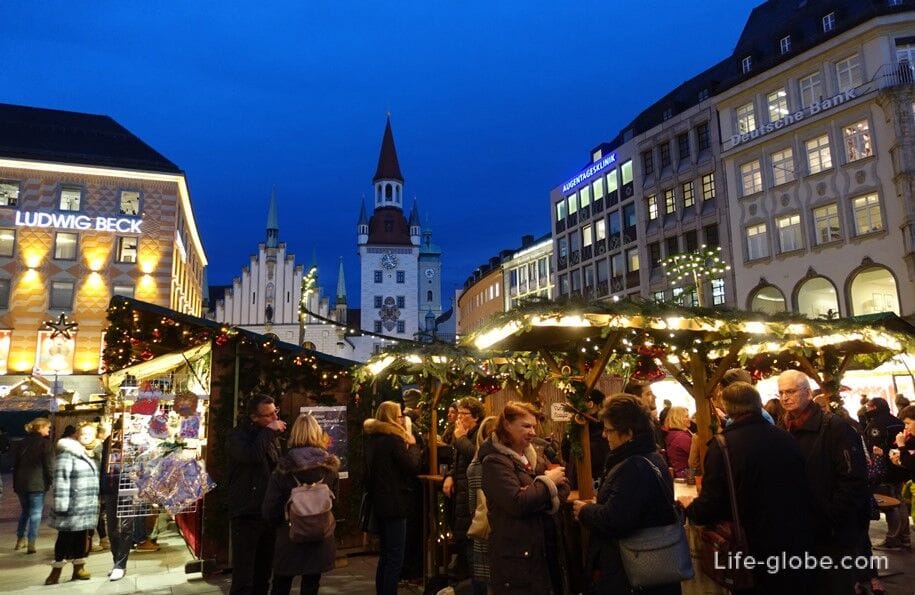
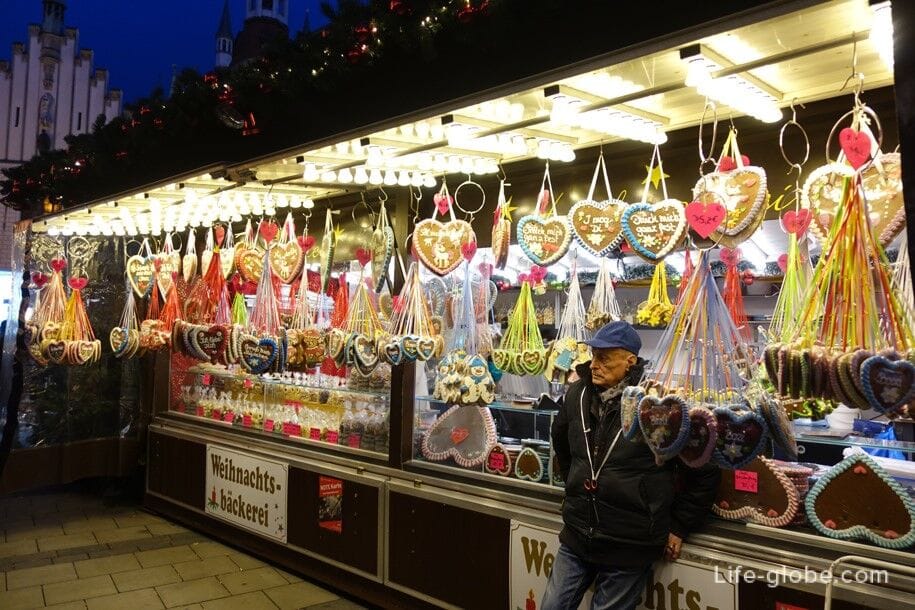

In the tower-the bell tower of St. Peter's Church, located close to Marienplatz, there is a circular observation deck, which offers views, including on the Marienplatz with the Old and New town halls. Read more about St Peter's Church and lookout.
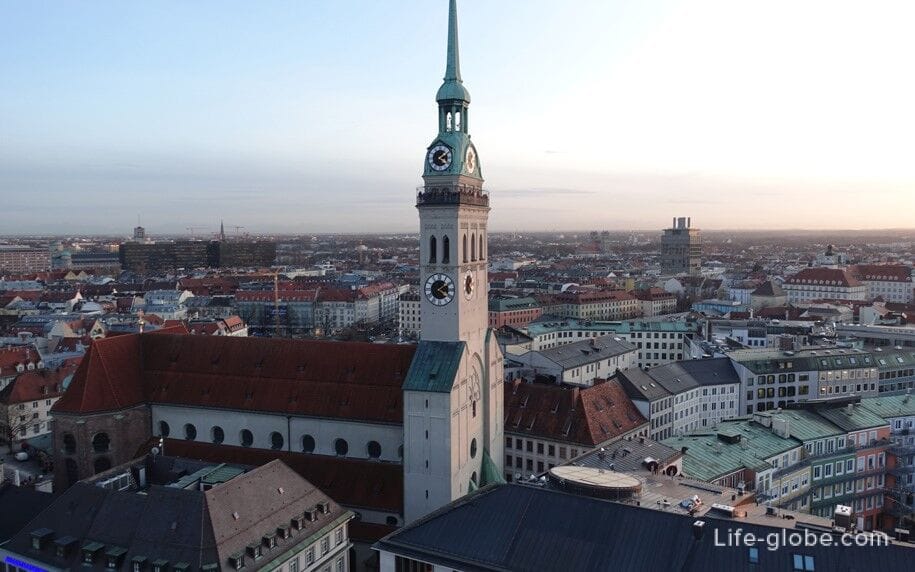
You can visit Marienplatz Square on your own or with one of the excursions around Munich
Hotel BEYOND by Geisel, located opposite the New town hall.
In the hotel: lounge area, bar, Parking, free Wi-Fi, hour front Desk and a shared kitchen with a dining area.
In rooms: air conditioning, flat-screen TV and Bluetooth speakers. The bathroom has a rain shower.
Room rates include Breakfast. Link to the hotel
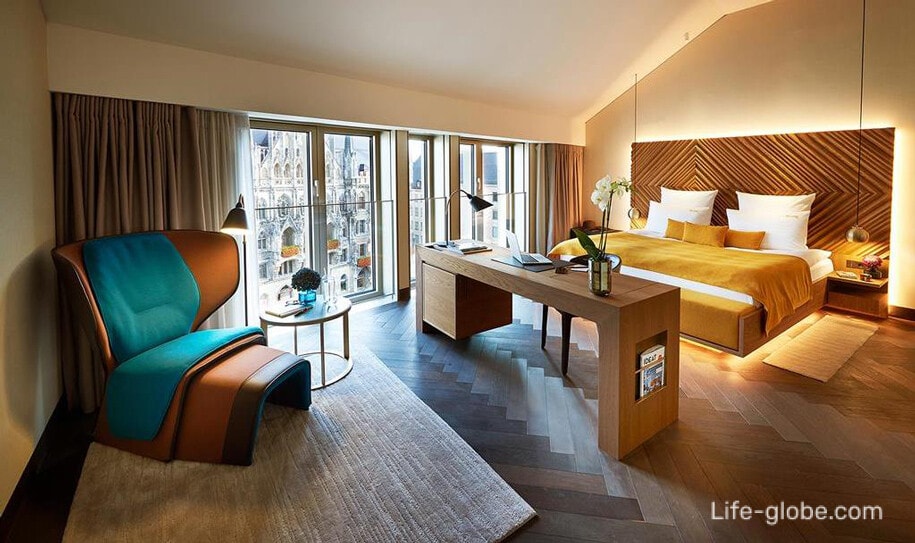
Louis with a Japanese restaurant, a bar, a fitness centre and Parking.
In rooms: flat screen TV, DVD player, dock iPod, air conditioning and a French balcony.
Room rates may include Breakfast. Link to the hotel
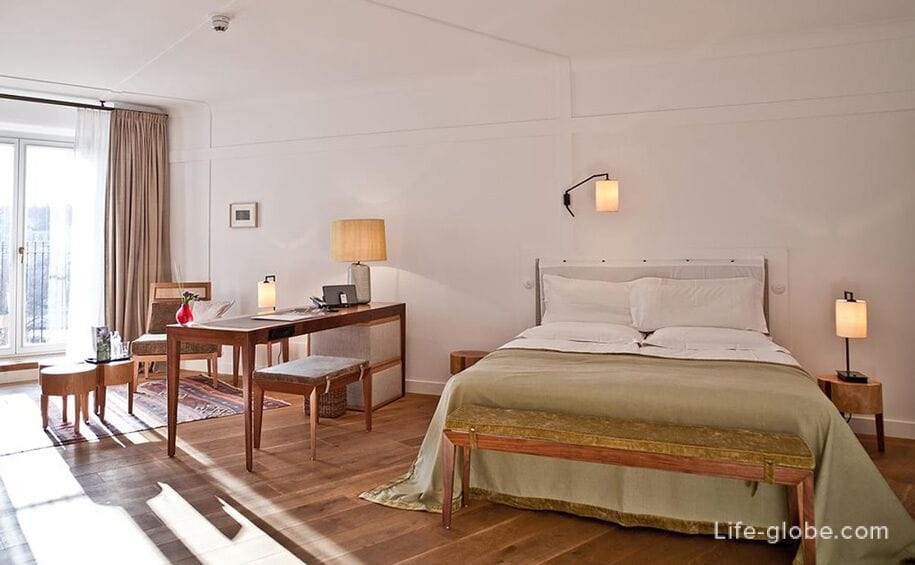
The 3-star hotel Schlicker with free Wi-Fi, free Parking, free Bicycle rental and family rooms.
Room rates include Breakfast. Link to the hotel

All accommodation in Munich, including near Marienplatz in Munich's Old town, you can view and book here